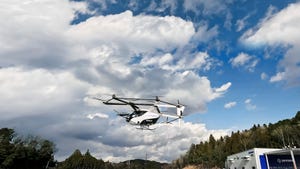Jumping Robot Sets New World Record, Reaches Nearly 400 FeetJumping Robot Sets New World Record, Reaches Nearly 400 Feet
The robot could be used to explore other planets

A robot has set a new world record by jumping 393 feet, shattering the previous record of 108 feet for the highest jump by a robot.
Robotics engineers at the University of Manchester discovered the optimal shapes and sizes required for a robot to jump to new heights through extensive computer simulations and laboratory experiments.
They found that previous jumping robots would take off before fully releasing their stored spring energy, resulting in poor jumps that limit maximum height potentials.
The new robot does not take off until it has fully compressed the spring. It maintains structural strength and stiffness when bending down to jump before leaping straight up into the air like a mechanical frog.
Detailed in a newly published paper in the Mechanism and Machine Theory journal, the minds behind it believe the robot could be used to reach inaccessible spaces or help in disaster rescue.
“Our structural redesigns redistribute the robot’s component mass towards the top and taper the structure towards the bottom,” said Ben Parslew, Senior Lecturer in Aerospace Engineering at the University of Manchester. “Lighter legs in the shape of a prism and using springs that only stretch are all properties that we have shown to improve the performance and most importantly, the energy efficiency of the jumping robot.”
The researchers now intend to enhance the robot by enabling control of the direction of its jumps.
The engineers also want to determine how to capture the kinetic energy from its landing to enhance the number of jumps the robot can perform on a single charge.
The robot would be able to jump to heights of 656 feet on the Moon and the researchers plan to develop more compact designs specifically for space missions to make it easier to transport to distant planets.
“Robots are traditionally designed to move by rolling on wheels or using legs to walk, but jumping provides an effective way of traveling around locations where the terrain is very uneven, or where there are a lot of obstacles, such as inside caves, through forests, over boulders or even the surface of other planets in space,” said John Lo, research associate in space robotics at the University of Manchester.
About the Author
You May Also Like
.jpg?width=100&auto=webp&quality=80&disable=upscale)
.jpg?width=400&auto=webp&quality=80&disable=upscale)




